weight DODGE DART 2014 PF / 1.G Owners Manual
[x] Cancel search | Manufacturer: DODGE, Model Year: 2014, Model line: DART, Model: DODGE DART 2014 PF / 1.GPages: 656, PDF Size: 4.73 MB
Page 64 of 656
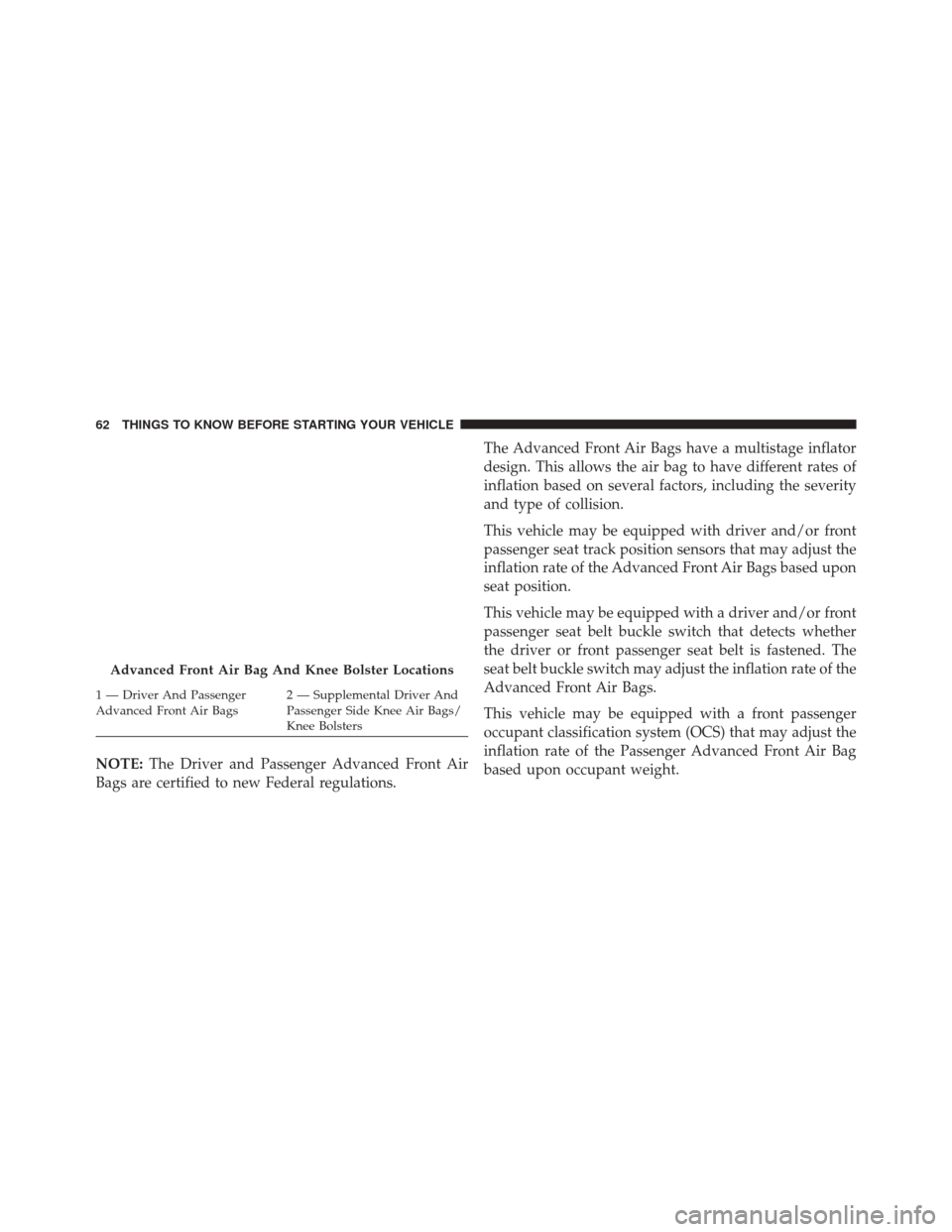
NOTE:The Driver and Passenger Advanced Front Air
Bags are certified to new Federal regulations. The Advanced Front Air Bags have a multistage inflator
design. This allows the air bag to have different rates of
inflation based on several factors, including the severity
and type of collision.
This vehicle may be equipped with driver and/or front
passenger seat track position sensors that may adjust the
inflation rate of the Advanced Front Air Bags based upon
seat position.
This vehicle may be equipped with a driver and/or front
passenger seat belt buckle switch that detects whether
the driver or front passenger seat belt is fastened. The
seat belt buckle switch may adjust the inflation rate of the
Advanced Front Air Bags.
This vehicle may be equipped with a front passenger
occupant classification system (OCS) that may adjust the
inflation rate of the Passenger Advanced Front Air Bag
based upon occupant weight.
Advanced Front Air Bag And Knee Bolster Locations
1 — Driver And Passenger
Advanced Front Air Bags
2 — Supplemental Driver And
Passenger Side Knee Air Bags/
Knee Bolsters
62 THINGS TO KNOW BEFORE STARTING YOUR VEHICLE
Page 68 of 656
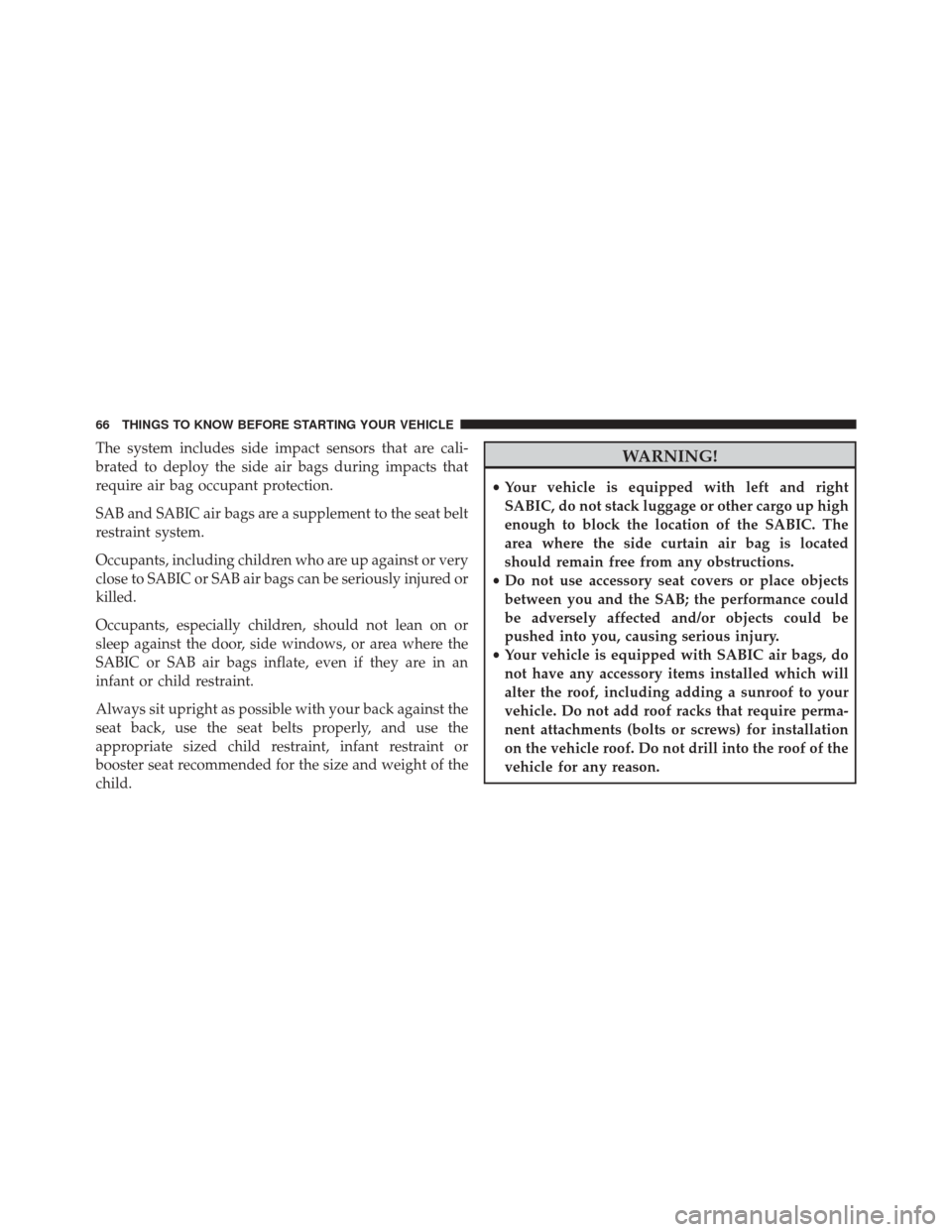
The system includes side impact sensors that are cali-
brated to deploy the side air bags during impacts that
require air bag occupant protection.
SAB and SABIC air bags are a supplement to the seat belt
restraint system.
Occupants, including children who are up against or very
close to SABIC or SAB air bags can be seriously injured or
killed.
Occupants, especially children, should not lean on or
sleep against the door, side windows, or area where the
SABIC or SAB air bags inflate, even if they are in an
infant or child restraint.
Always sit upright as possible with your back against the
seat back, use the seat belts properly, and use the
appropriate sized child restraint, infant restraint or
booster seat recommended for the size and weight of the
child.WARNING!
•Your vehicle is equipped with left and right
SABIC, do not stack luggage or other cargo up high
enough to block the location of the SABIC. The
area where the side curtain air bag is located
should remain free from any obstructions.
• Do not use accessory seat covers or place objects
between you and the SAB; the performance could
be adversely affected and/or objects could be
pushed into you, causing serious injury.
• Your vehicle is equipped with SABIC air bags, do
not have any accessory items installed which will
alter the roof, including adding a sunroof to your
vehicle. Do not add roof racks that require perma-
nent attachments (bolts or screws) for installation
on the vehicle roof. Do not drill into the roof of the
vehicle for any reason.
66 THINGS TO KNOW BEFORE STARTING YOUR VEHICLE
Page 72 of 656
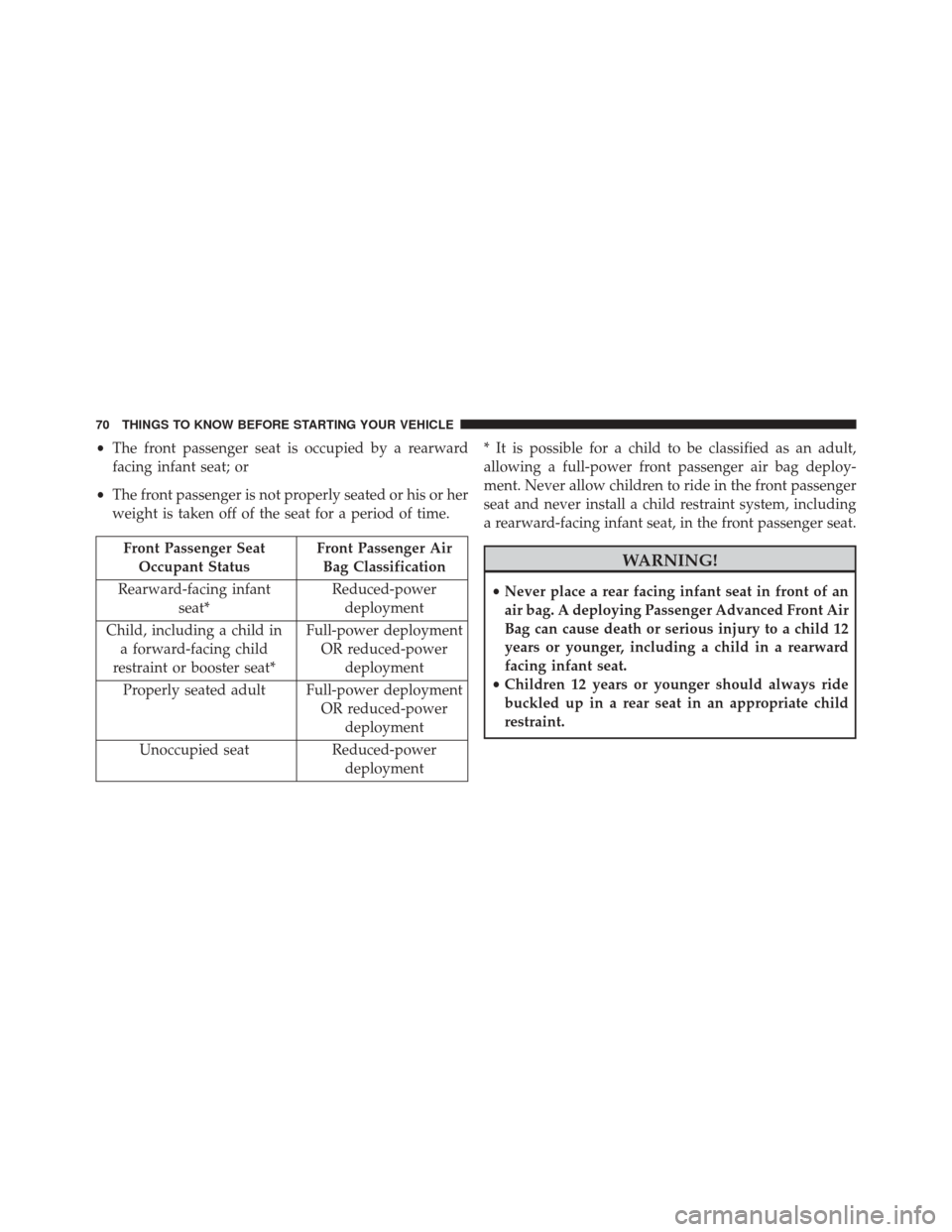
•The front passenger seat is occupied by a rearward
facing infant seat; or
• The front passenger is not properly seated or his or her
weight is taken off of the seat for a period of time.
Front Passenger Seat
Occupant Status Front Passenger Air
Bag Classification
Rearward-facing infant seat* Reduced-power
deployment
Child, including a child in a forward-facing child
restraint or booster seat* Full-power deployment
OR reduced-power deployment
Properly seated adult Full-power deployment OR reduced-powerdeployment
Unoccupied seat Reduced-power deployment* It is possible for a child to be classified as an adult,
allowing a full-power front passenger air bag deploy-
ment. Never allow children to ride in the front passenger
seat and never install a child restraint system, including
a rearward-facing infant seat, in the front passenger seat.WARNING!
•
Never place a rear facing infant seat in front of an
air bag. A deploying Passenger Advanced Front Air
Bag can cause death or serious injury to a child 12
years or younger, including a child in a rearward
facing infant seat.
• Children 12 years or younger should always ride
buckled up in a rear seat in an appropriate child
restraint.
70 THINGS TO KNOW BEFORE STARTING YOUR VEHICLE
Page 73 of 656
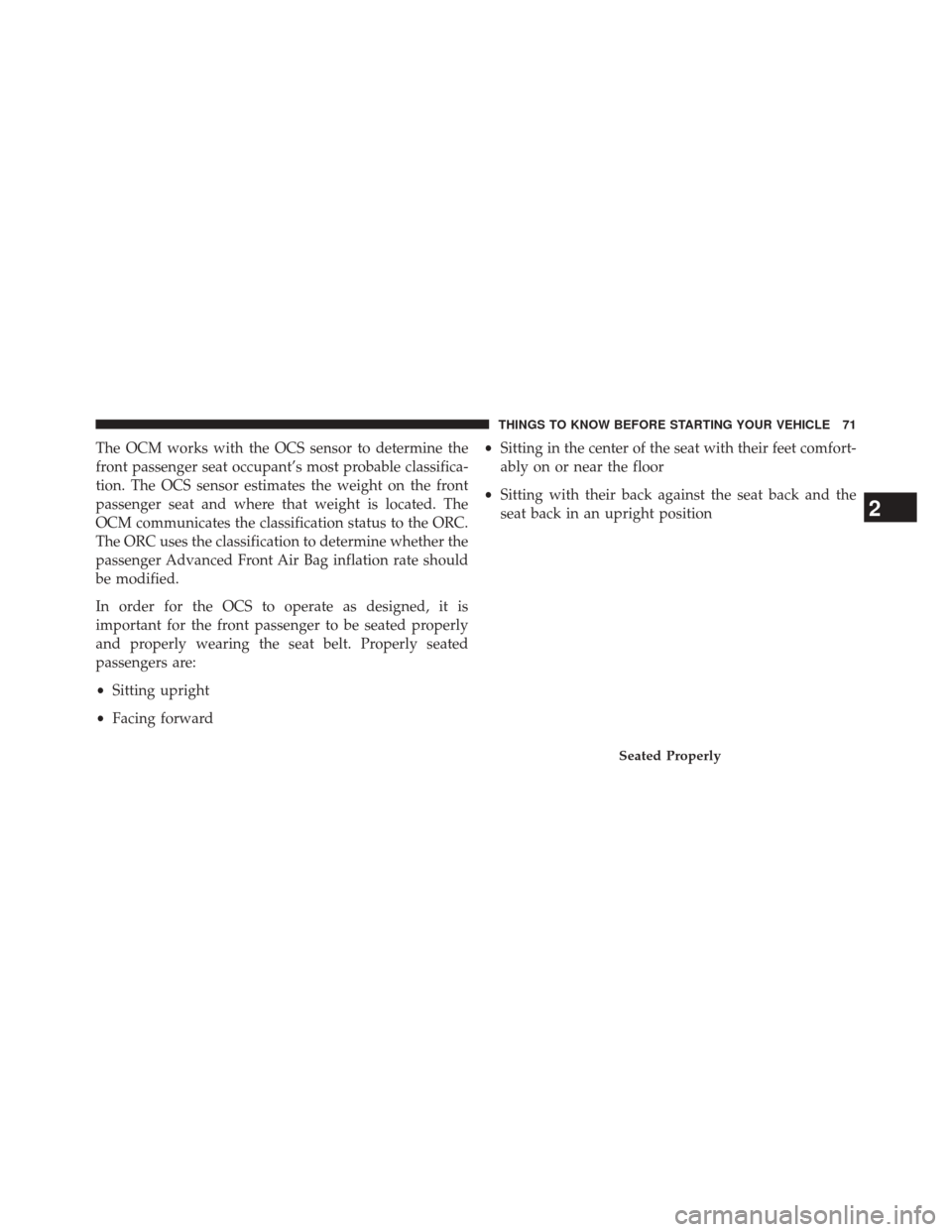
The OCM works with the OCS sensor to determine the
front passenger seat occupant’s most probable classifica-
tion. The OCS sensor estimates the weight on the front
passenger seat and where that weight is located. The
OCM communicates the classification status to the ORC.
The ORC uses the classification to determine whether the
passenger Advanced Front Air Bag inflation rate should
be modified.
In order for the OCS to operate as designed, it is
important for the front passenger to be seated properly
and properly wearing the seat belt. Properly seated
passengers are:
•Sitting upright
• Facing forward •
Sitting in the center of the seat with their feet comfort-
ably on or near the floor
• Sitting with their back against the seat back and the
seat back in an upright position
Seated Properly
2
THINGS TO KNOW BEFORE STARTING YOUR VEHICLE 71
Page 74 of 656
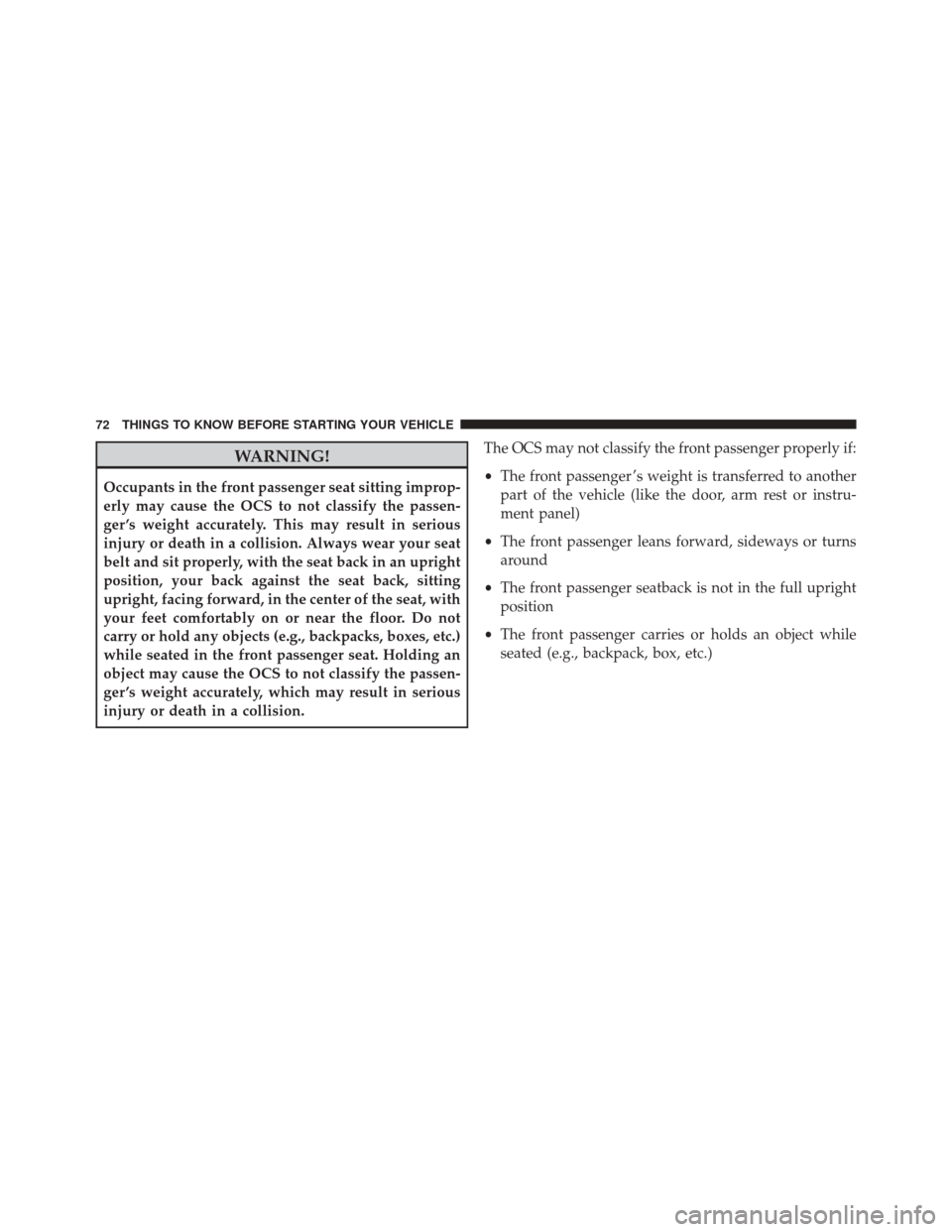
WARNING!
Occupants in the front passenger seat sitting improp-
erly may cause the OCS to not classify the passen-
ger ’s weight accurately. This may result in serious
injury or death in a collision. Always wear your seat
belt and sit properly, with the seat back in an upright
position, your back against the seat back, sitting
upright, facing forward, in the center of the seat, with
your feet comfortably on or near the floor. Do not
carry or hold any objects (e.g., backpacks, boxes, etc.)
while seated in the front passenger seat. Holding an
object may cause the OCS to not classify the passen-
ger ’s weight accurately, which may result in serious
injury or death in a collision.The OCS may not classify the front passenger properly if:
•
The front passenger ’s weight is transferred to another
part of the vehicle (like the door, arm rest or instru-
ment panel)
• The front passenger leans forward, sideways or turns
around
• The front passenger seatback is not in the full upright
position
• The front passenger carries or holds an object while
seated (e.g., backpack, box, etc.)
72 THINGS TO KNOW BEFORE STARTING YOUR VEHICLE
Page 78 of 656
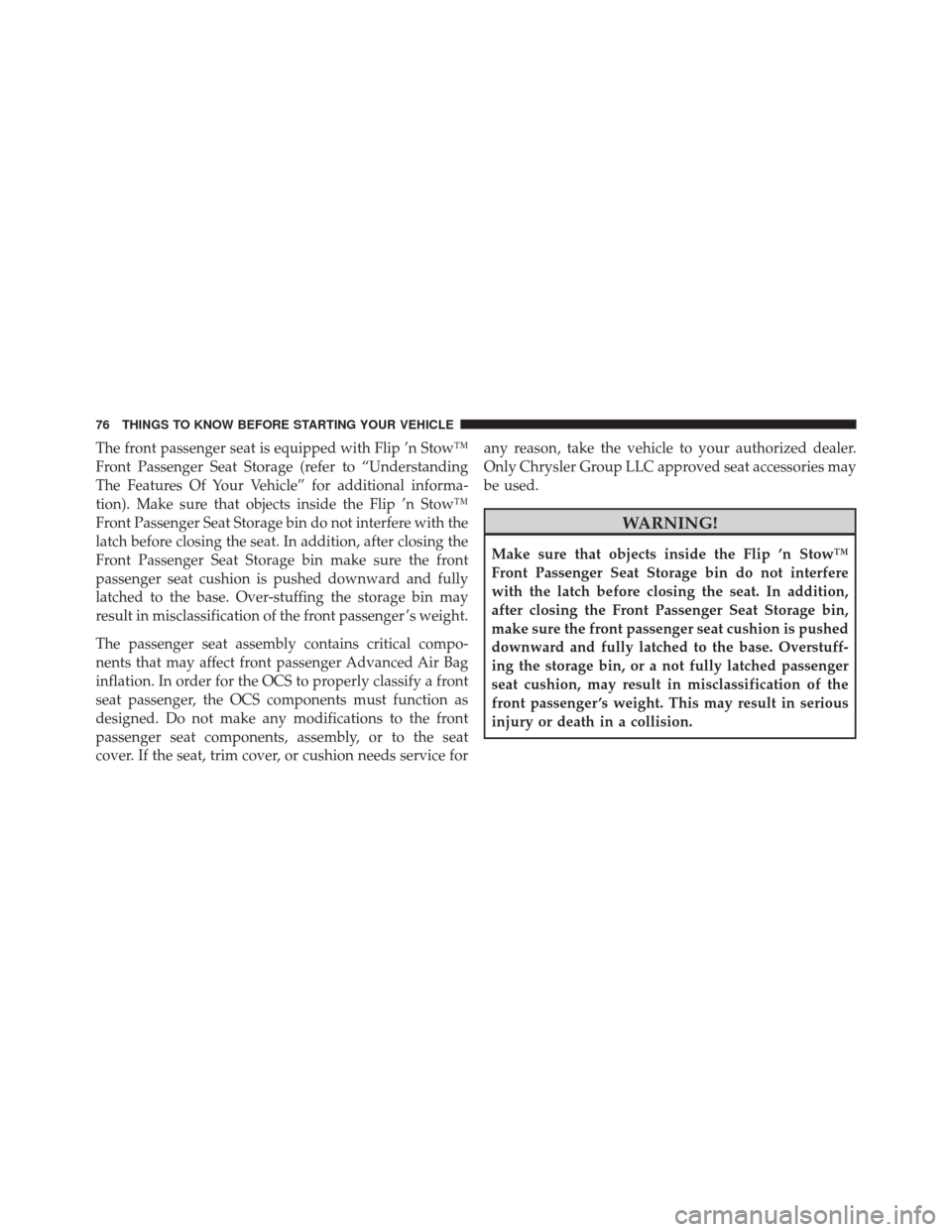
The front passenger seat is equipped with Flip ’n Stow™
Front Passenger Seat Storage (refer to “Understanding
The Features Of Your Vehicle” for additional informa-
tion). Make sure that objects inside the Flip ’n Stow™
Front Passenger Seat Storage bin do not interfere with the
latch before closing the seat. In addition, after closing the
Front Passenger Seat Storage bin make sure the front
passenger seat cushion is pushed downward and fully
latched to the base. Over-stuffing the storage bin may
result in misclassification of the front passenger ’s weight.
The passenger seat assembly contains critical compo-
nents that may affect front passenger Advanced Air Bag
inflation. In order for the OCS to properly classify a front
seat passenger, the OCS components must function as
designed. Do not make any modifications to the front
passenger seat components, assembly, or to the seat
cover. If the seat, trim cover, or cushion needs service forany reason, take the vehicle to your authorized dealer.
Only Chrysler Group LLC approved seat accessories may
be used.
WARNING!
Make sure that objects inside the Flip ’n Stow™
Front Passenger Seat Storage bin do not interfere
with the latch before closing the seat. In addition,
after closing the Front Passenger Seat Storage bin,
make sure the front passenger seat cushion is pushed
downward and fully latched to the base. Overstuff-
ing the storage bin, or a not fully latched passenger
seat cushion, may result in misclassification of the
front passenger ’s weight. This may result in serious
injury or death in a collision.
76 THINGS TO KNOW BEFORE STARTING YOUR VEHICLE
Page 88 of 656
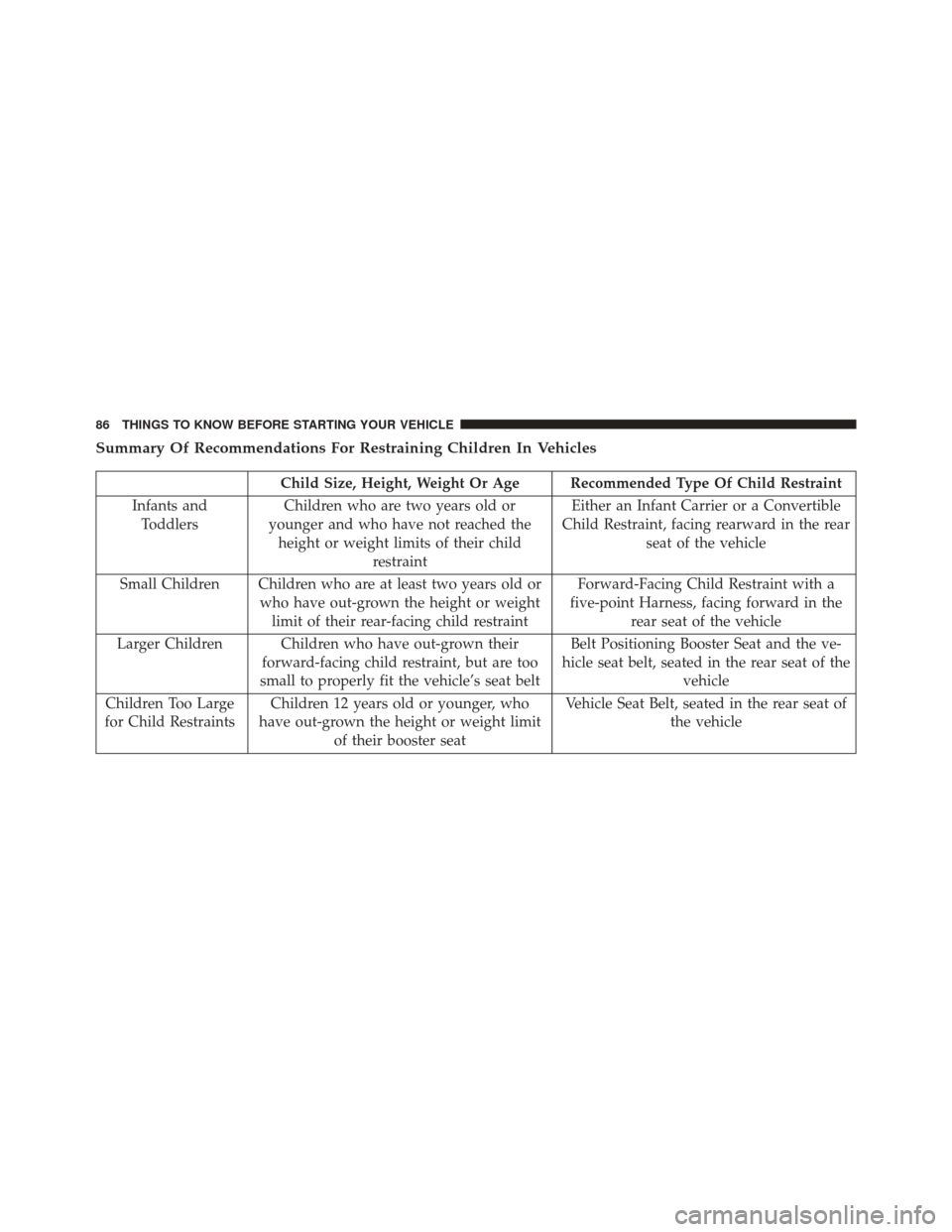
Summary Of Recommendations For Restraining Children In Vehicles
Child Size, Height, Weight Or Age Recommended Type Of Child Restraint
Infants and Toddlers Children who are two years old or
younger and who have not reached the height or weight limits of their child restraint Either an Infant Carrier or a Convertible
Child Restraint, facing rearward in the rear seat of the vehicle
Small Children Children who are at least two years old or who have out-grown the height or weightlimit of their rear-facing child restraint Forward-Facing Child Restraint with a
five-point Harness, facing forward in the rear seat of the vehicle
Larger Children Children who have out-grown their forward-facing child restraint, but are too
small to properly fit the vehicle’s seat belt Belt Positioning Booster Seat and the ve-
hicle seat belt, seated in the rear seat of the vehicle
Children Too Large
for Child Restraints Children 12 years old or younger, who
have out-grown the height or weight limit of their booster seat Vehicle Seat Belt, seated in the rear seat of
the vehicle
86 THINGS TO KNOW BEFORE STARTING YOUR VEHICLE
Page 89 of 656
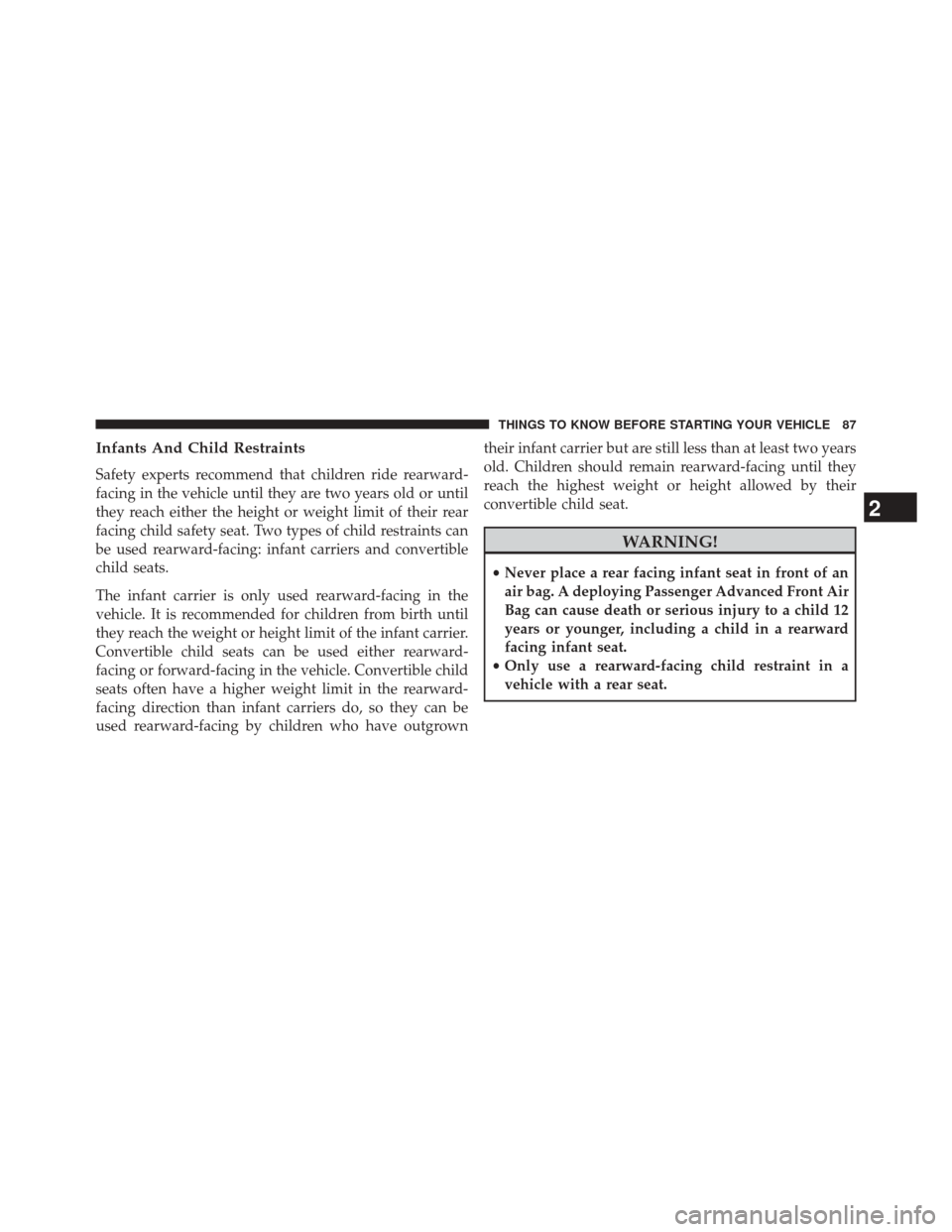
Infants And Child Restraints
Safety experts recommend that children ride rearward-
facing in the vehicle until they are two years old or until
they reach either the height or weight limit of their rear
facing child safety seat. Two types of child restraints can
be used rearward-facing: infant carriers and convertible
child seats.
The infant carrier is only used rearward-facing in the
vehicle. It is recommended for children from birth until
they reach the weight or height limit of the infant carrier.
Convertible child seats can be used either rearward-
facing or forward-facing in the vehicle. Convertible child
seats often have a higher weight limit in the rearward-
facing direction than infant carriers do, so they can be
used rearward-facing by children who have outgrowntheir infant carrier but are still less than at least two years
old. Children should remain rearward-facing until they
reach the highest weight or height allowed by their
convertible child seat.
WARNING!
•
Never place a rear facing infant seat in front of an
air bag. A deploying Passenger Advanced Front Air
Bag can cause death or serious injury to a child 12
years or younger, including a child in a rearward
facing infant seat.
• Only use a rearward-facing child restraint in a
vehicle with a rear seat.
2
THINGS TO KNOW BEFORE STARTING YOUR VEHICLE 87
Page 90 of 656
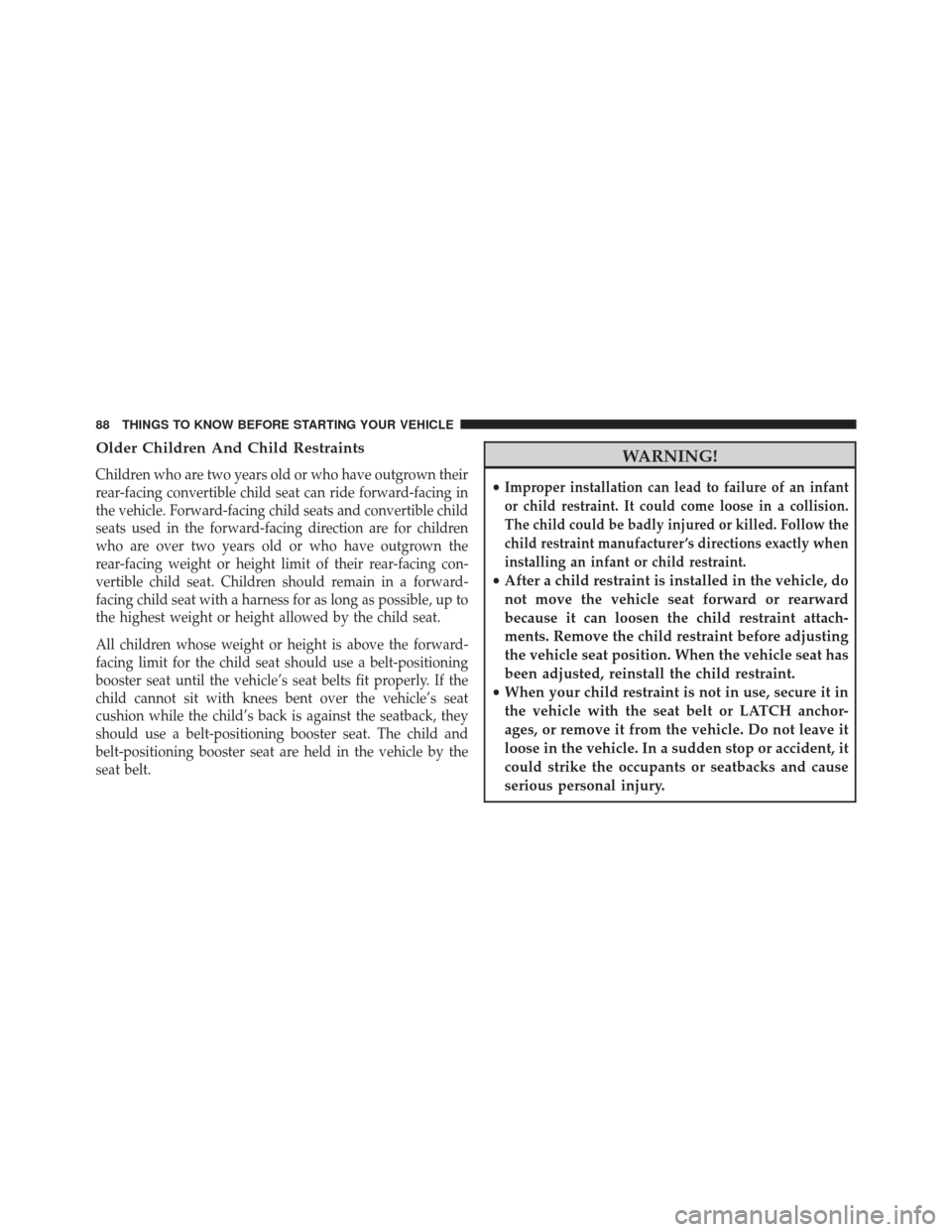
Older Children And Child Restraints
Children who are two years old or who have outgrown their
rear-facing convertible child seat can ride forward-facing in
the vehicle. Forward-facing child seats and convertible child
seats used in the forward-facing direction are for children
who are over two years old or who have outgrown the
rear-facing weight or height limit of their rear-facing con-
vertible child seat. Children should remain in a forward-
facing child seat with a harness for as long as possible, up to
the highest weight or height allowed by the child seat.
All children whose weight or height is above the forward-
facing limit for the child seat should use a belt-positioning
booster seat until the vehicle’s seat belts fit properly. If the
child cannot sit with knees bent over the vehicle’s seat
cushion while the child’s back is against the seatback, they
should use a belt-positioning booster seat. The child and
belt-positioning booster seat are held in the vehicle by the
seat belt.
WARNING!
•Improper installation can lead to failure of an infant
or child restraint. It could come loose in a collision.
The child could be badly injured or killed. Follow the
child restraint manufacturer ’s directions exactly when
installing an infant or child restraint.
•After a child restraint is installed in the vehicle, do
not move the vehicle seat forward or rearward
because it can loosen the child restraint attach-
ments. Remove the child restraint before adjusting
the vehicle seat position. When the vehicle seat has
been adjusted, reinstall the child restraint.
• When your child restraint is not in use, secure it in
the vehicle with the seat belt or LATCH anchor-
ages, or remove it from the vehicle. Do not leave it
loose in the vehicle. In a sudden stop or accident, it
could strike the occupants or seatbacks and cause
serious personal injury.
88 THINGS TO KNOW BEFORE STARTING YOUR VEHICLE
Page 92 of 656
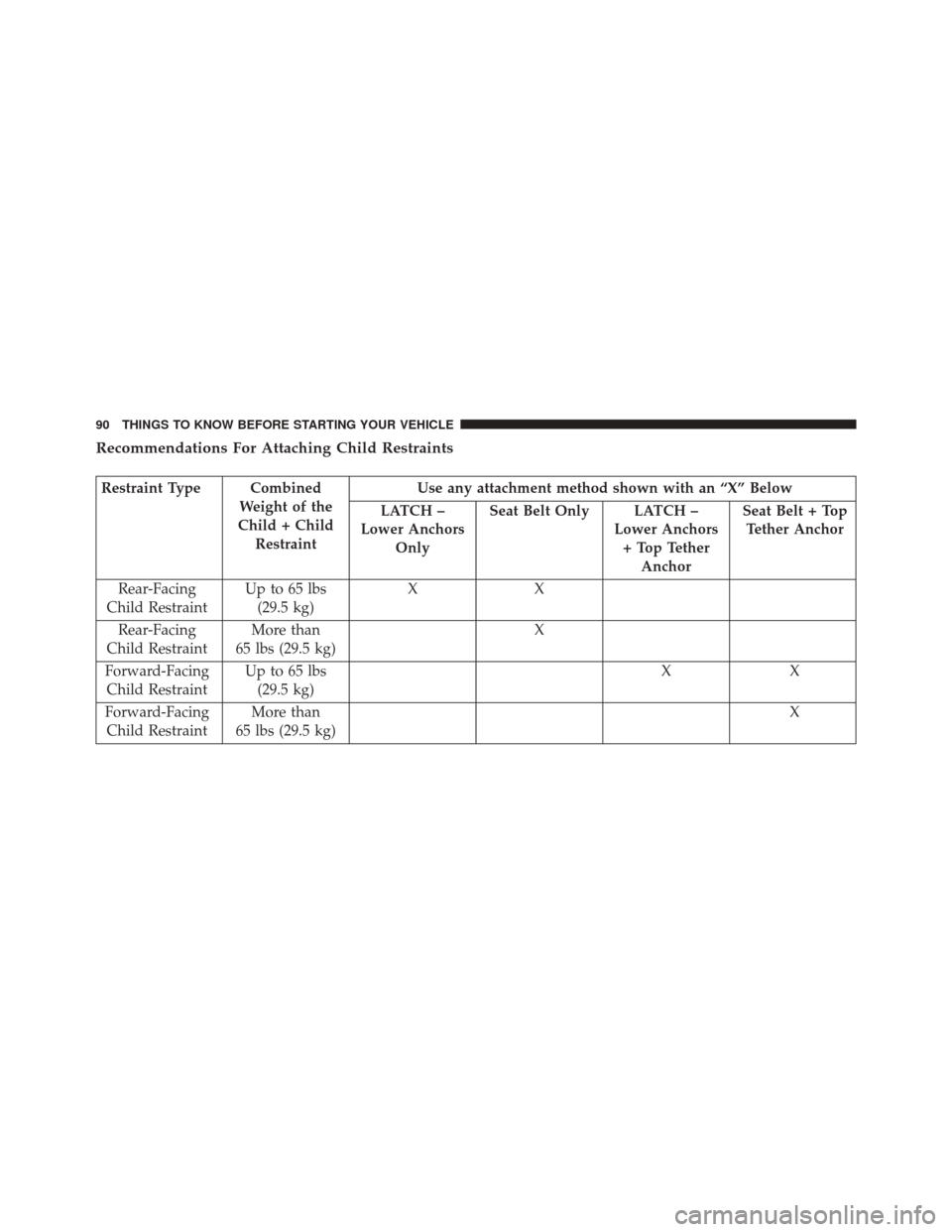
Recommendations For Attaching Child Restraints
Restraint Type CombinedWeight of the
Child + Child Restraint Use any attachment method shown with an “X” Below
LATCH –
Lower Anchors Only Seat Belt Only LATCH –
Lower Anchors+ Top Tether Anchor Seat Belt + Top
Tether Anchor
Rear-Facing
Child Restraint Up to 65 lbs
(29.5 kg) XX
Rear-Facing
Child Restraint More than
65 lbs (29.5 kg) X
Forward-Facing Child Restraint Up to 65 lbs
(29.5 kg) XX
Forward-Facing Child Restraint More than
65 lbs (29.5 kg) X
90 THINGS TO KNOW BEFORE STARTING YOUR VEHICLE